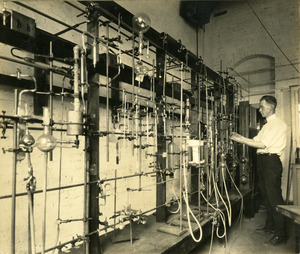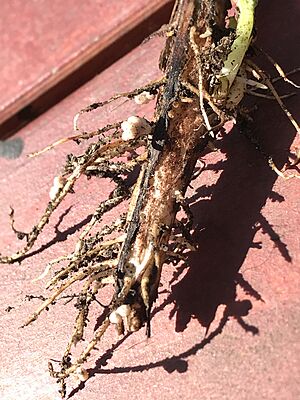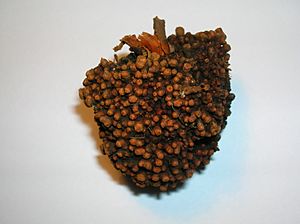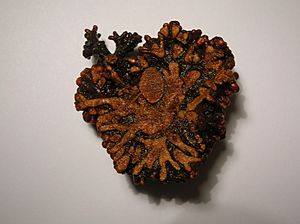Nitrogen fixation facts for kids

Nitrogen fixation is a super important natural process. It's how nitrogen gas (N2) from the air gets changed into other forms of nitrogen, like ammonia or nitrate. These new forms are really useful for living things and for different chemical processes. This process is a big part of the nitrogen cycle, which is how nitrogen moves around our planet.
Nitrogen can be fixed in two main ways: by living things (biological) or by non-living things (non-biological).
Contents
Biological Nitrogen Fixation
This is when tiny living things, mostly special microorganisms, change nitrogen gas into forms that plants can use.
Nitrogen-Fixing Microorganisms (Diazotrophs)
Many different types of tiny organisms, called diazotrophs, can fix nitrogen. Here are some of the most important ones:
- Cyanobacteria: These are often called blue-green algae, and they are found almost everywhere on Earth. A very important one is Trichodesmium.
- Green sulfur bacteria
- Azotobacteraceae
- Rhizobia
- Frankia bacteria: These are Gram-positive soil bacteria that help certain plants fix nitrogen.
Cyanobacteria are found in most places on Earth. They play a huge role in how carbon and nitrogen move through our planet. They can use many different sources of nitrogen, like nitrate or ammonium. Some types of cyanobacteria can also fix nitrogen from the air. Scientists think this ability might have been around for a very long time, possibly since the first living things appeared.
In places like coral reefs, cyanobacteria can fix a lot of nitrogen – sometimes twice as much as on land! One type of marine cyanobacteria, Trichodesmium, is so good at it that it might be responsible for almost half of all nitrogen fixation in the oceans worldwide.
Root Nodule Partnerships
Some plants have special partnerships with nitrogen-fixing bacteria. These partnerships often happen in structures called nodules on the plant's roots.
Legume Plants
Many plants in the legume family (also known as Fabaceae) are great at nitrogen fixation. This family includes plants like kudzu, clovers, soybeans, alfalfa, lupines, peanuts, and rooibos.
These plants have a special relationship with bacteria called Rhizobia. The bacteria live inside small bumps, or nodules, on the plant's roots. The bacteria change nitrogen gas into nitrogen compounds that help the plant grow. This partnership helps the plant get the nitrogen it needs and even compete better with other plants. When the plant dies, the nitrogen it fixed is released into the soil, which helps to fertilize it for other plants.
Most legumes have this helpful partnership. Farmers often use a practice called "crop rotation." This means they grow different types of crops in a field over time, often including a crop of clover or buckwheat. These plants are sometimes called "green manure" because they help add nitrogen back into the soil.
Other Plants with Root Nodules
While most plants that form nitrogen-fixing root nodules are legumes, there are a few other types of plants that can do it too:
- Parasponia: This is a tropical plant that can also work with Rhizobia bacteria to form nitrogen-fixing nodules.
- Actinorhizal plants: These plants, like alder and bayberry, can also form nitrogen-fixing nodules. They do this thanks to a partnership with Frankia bacteria. These plants belong to about 25 different groups (genera) across eight plant families. However, not every plant in these families can fix nitrogen. For example, out of 122 groups in the Rosaceae family, only four can fix nitrogen.
Scientists believe that the ability to fix nitrogen in these plant groups might have been lost over time in many plants, even though their ancestors could do it.
Two scientists, Hermann Hellnegel (1831–1895) and Martinus Beijerinck (1851–1931), were important in discovering how biological nitrogen fixation works.
Non-Biological Nitrogen Fixation
Nitrogen can also be fixed without the help of living organisms.
- Lightning: When lightning flashes, it heats the air around it to extreme temperatures. This intense heat causes nitrogen gas and oxygen gas in the air to combine, forming nitric oxide (NO). This is important for the chemistry of the air, but it doesn't fix enough nitrogen to be a major source for life on Earth.
- The Haber process: This is a human-made process used in factories. Nitrogen gas is combined with hydrogen gas under high pressure and temperature to create ammonia. This ammonia is then used to make fertilizer for farms and also for explosives.
- Burning: When things burn, like in a forest fire, the high temperatures can also cause nitrogen and oxygen to combine, forming nitrogen compounds.
Images for kids
See also
 In Spanish: Fijación de nitrógeno para niños
In Spanish: Fijación de nitrógeno para niños





